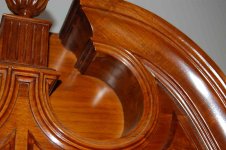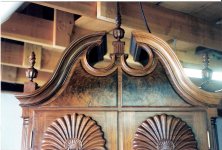What if I were to modify the design of the piece to include quarter columns? Who thinks that would look better? Any pitfalls there? Presumably the upper section only would have the quarter columns, as my quick perusal of the books doesn?t show any desk units with quarter columns. Anybody ever build a desk unit with quarter columns?
Take for instance the quarter columns found in a documented Townsend highboy or chest on chest. These are not overly difficult to make, yet they require a very fine touch. They?re closely architectural but very much stretched lengthwise in respect to classical column proportions. This stretching works perfectly on these pieces, whereas it would look ridiculous in a building. My guess is that a Newport clock case column is less stretched than the drawercase counterpart, but I don?t know. Anybody know anything about this?.
In my mind the quarter column detail adds a very pleasing, softening aspect to drawercase work. The extra cost and work to include it in a case piece is worth every penny and drop of sweat.
The base is an Attic type while the capital is pretty classical Ionic. The proportioning and detailing of each of these elements is very well done and very finely turned. The diameter of the column matches perfectly to the separately turned base and capital parts. There is very little detectable evidence of tool marks of any kind on the exterior surfaces of all of John Townsends work, and this applies to the quarter column turnings. None of the turning appears to have been sanded, none of the details are blurred. Fortunately for us, most of the pieces seem to have escaped serious damage during inevitable refinishings over 250 years. You can, still today, see this. The column part of the feature is perfectly fluted, five flutes usually. They are dead straight, with the intervening flat spots (not truly flat, I?m referring to the uncarved part) left the same width across the hole ?carving??. The last flat part where the column joins the case is half of the interflute ??.shmarg. It?s a sure bet that the column fluting was done by means of a jig guided scraper. The work would be held in a jig and the scraper would be mounted in a separate custom made wooden hand tool. How do you guys do it? Do you flute them before or after separation of the paper joint? Does the jig hold a round turning or a quarter column?
Free hand carving something to this level seems impossible to me. I tried it once, and quickly it became clear that I?d underappreciated the challenge. It?s not a part of the ornamentation that jumps out at you as being high level.
Attempting to carve them to final finish only with carving tools is tougher than you might guess. Small errors in lines close together are easy to spot; Townsend?s work shows no such deviations. It?s tough to keep closely spaced straight parallel lines truly straight and parallel only with carving tools. For no good reason, I tend to consider straightening the flute carving with files (like a chain saw file) as a cheat and dead end. If I was goin? down that road again though, I?d plan to use a chain saw file in advance. Helps when you know where you?re going. In either I approach, I?d have to finish up with fine sandpaper wrapped around a dowel. I wonder if Townsend did.
I?m also convinced that we now do quarter columns they same way they did: paper-gluing up four prepared pieces of stock, each sized close to the desired finish radius. Their lathes were slow, nothing like even close to what we?d consider slow on our machines today. Yet all the books suggest that sandpaper was only little available, and grindpaper (100 grit range) was unknown. I don?t know. I do know that when I turn a quarter column and I want a long skinny piece of wood to a consistent diameter, I have to use a center support and even though I turn down to carefully gauged diameters, and clean out between, doing the fine finish only with lathe tools isn?t something I?m capable of achieving. It would require years of daily practice for me to get that good, and to me the lathe is largely an acessory, not a centerpiece of my shop activities. To really get it right, I use grindpaper and sandpaper on a long stick to get it as consistent as possible. Yet I don?t think Townsend did that, but who knows? Who spends time thinking about this stuff anyway?
The pieces are not stop fluted, yet this is perfectly acceptable and in no wise to be considered cheap work. In architectural work or in house joinery work, such a thing is to be considered strictly Gevoightescheisse. In closing I?ll note that the one place I can think of offhandedlly where John Townsend did stop fluting is in the finial plinths on big case furniture. These are a little bit rough in a couple spots, but I?m glad because it makes him humanoid. I?ve likewise found that hand carving the stop flute termination and getting it geometrical and clean is tough. Nawsty grain changes and all that sort of thing you know.
Pip Pip, cheero, toodle-oo, up , up and away!


